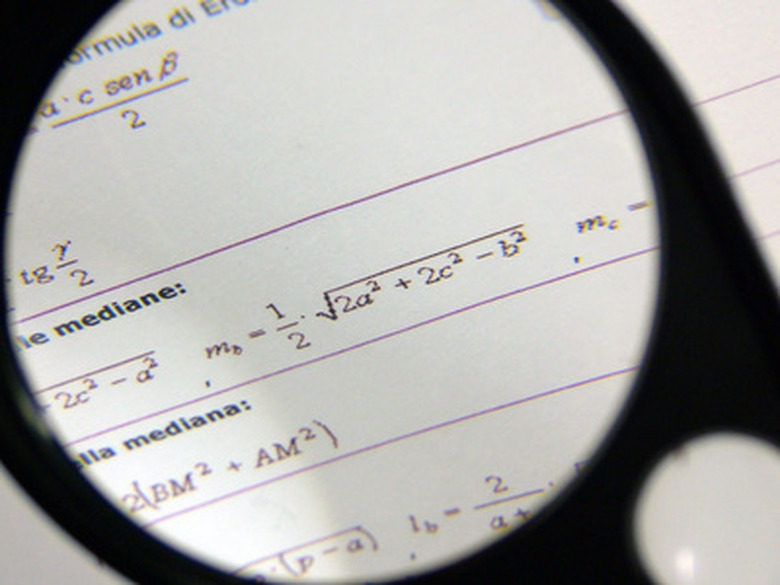How To Factor Higher Exponents
Learning to factor exponents higher than two is a simple algebraic process that is often forgotten after high school. Knowing how to factor exponents is important for finding the greatest common factor, which is essential in factoring polynomials. When the powers of a polynomial increase, it might seem increasingly difficult to factor the equation. Even so, using the combination of the greatest common factor and the guess-and-check method will allow you to solve higher degree polynomials.
Factoring Polynomials of Four or More Terms
Step 1
Find the greatest common factor (GCF), or the largest numerical expression that divides into two or more expressions without a remainder. Choose the least exponent for each factor. For example, the GCF of the two terms (3x^3 + 6x^2) and (6x^2 – 24) is 3(x + 2). You can see this because (3x^3 + 6x^2) = (3x_x^2 + 3_2x^2). So you can factor the common terms out, giving 3x^2(x + 2). For the second term, you know that (6x^2 – 24) = (6x^2 – 6_4). Factoring out the common terms gives 6(x^2 – 4), which is also 2_3(x + 2)(x – 2). Finally, pull out the lowest power of the terms that are in both expressions, giving 3(x + 2).
Step 2
Use the factor by grouping method if there are at least four terms in the expression. Group the first two terms together, then group the last two terms together. For example, from the expression x^3 + 7x^2 + 2x + 14, you would get two groups of two terms, (x^3 + 7x^2) + (2x + 14). Skip to the second section if you have three terms.
Step 3
Factor out the GCF from each binomial in the equation. For example, for the expression (x^3 + 7x^2) + (2x + 14), the GCF of the first binomial is x^2 and the GCF of the second binomial is 2. So, you get x^2(x + 7)+ 2(x + 7).
Step 4
Factor out the common binomial and regroup the polynomial. For example, x^2(x + 7) + 2(x + 7) into (x + 7)(x^2 + 2), for example.
Factoring Polynomials of Three Terms
Step 1
Factor out a common monomial from the three terms. For example, you can factor a common monomial, x^4, out of 6x^5 + 5x^4 + x^6. Rearrange the terms inside of the parenthesis so that the exponents decrease from left to right, resulting in x^4(x^2 + 6x + 5).
Step 2
Factor the trinomial inside of the parenthesis by trial and error. For the example, you can search for a pair of numbers that adds up to the middle term and multiplies out to the third term because the leading coefficient is one. If the leading coefficient is not one, then look for numbers that multiply to the product of the leading coefficient and the constant term and add up to the middle term.
Step 3
Write two sets of parentheses with an 'x' term, separated by two blank spaces with a plus or minus sign. Decide if you need same or opposite signs, which depends on the last term. Place one number from the pair found in the previous step in one parenthesis, and the other number in the second parenthesis. In the example, you would get x^4(x + 5)(x + 1). Multiply out to verify the solution. If the leading coefficient was not one, multiply the numbers you found in Step 2 by x and replace the middle term with the sum of them. Then, factor by grouping. For example, consider 2x^2 + 3x + 1. The product of the leading coefficient and the constant term is two. The numbers that multiply to two and add to three are two and one. So you would write, 2x^2 + 3x + 1 = 2x^2 + 2x + x +1. Factor this by the method in the first section, giving (2x + 1)(x+1). Multiply out to verify the solution.
Things Needed
- Pencil
- Paper
TL;DR (Too Long; Didn't Read)
Check to see if your answer is correct. Multiply the answer out to obtain the original polynomial.
Cite This Article
MLA
Newman, Nicole. "How To Factor Higher Exponents" sciencing.com, https://www.sciencing.com/factor-higher-exponents-7645240/. 24 April 2017.
APA
Newman, Nicole. (2017, April 24). How To Factor Higher Exponents. sciencing.com. Retrieved from https://www.sciencing.com/factor-higher-exponents-7645240/
Chicago
Newman, Nicole. How To Factor Higher Exponents last modified August 30, 2022. https://www.sciencing.com/factor-higher-exponents-7645240/
